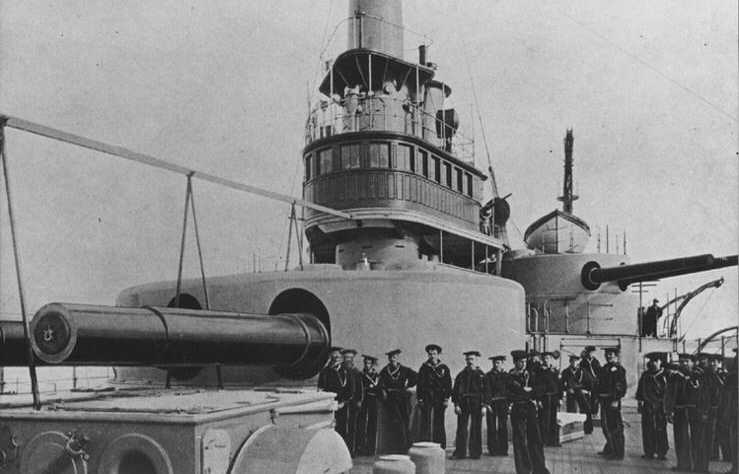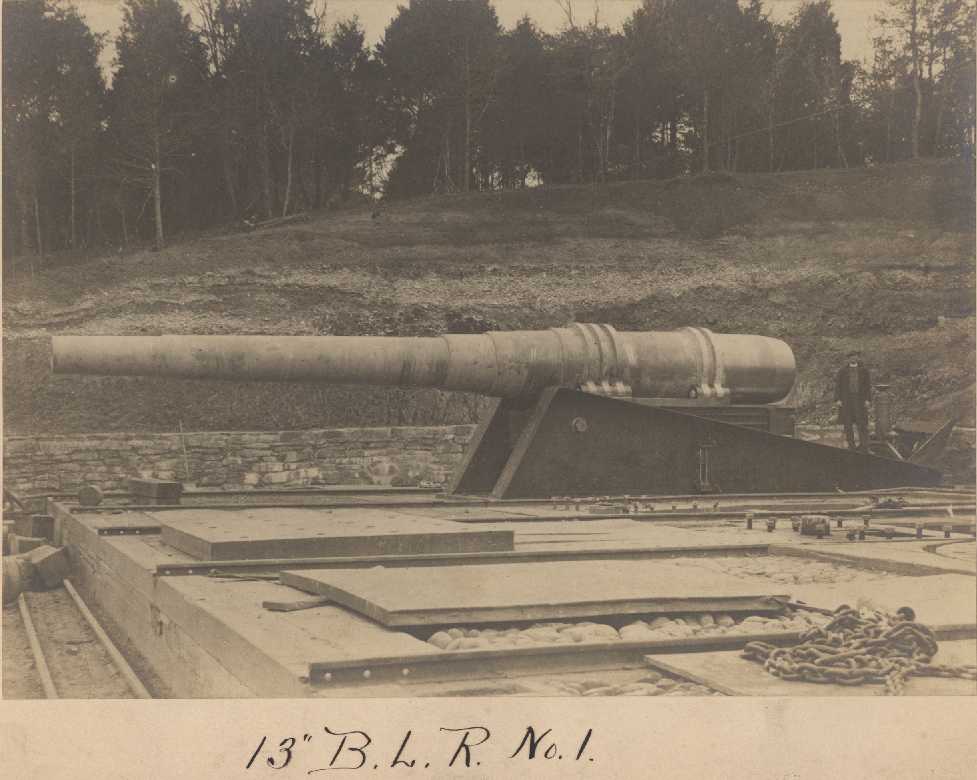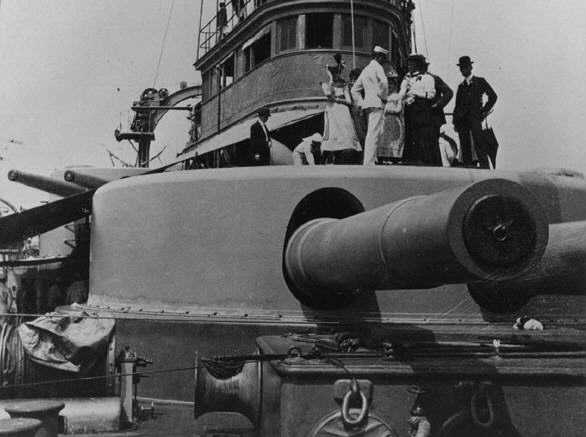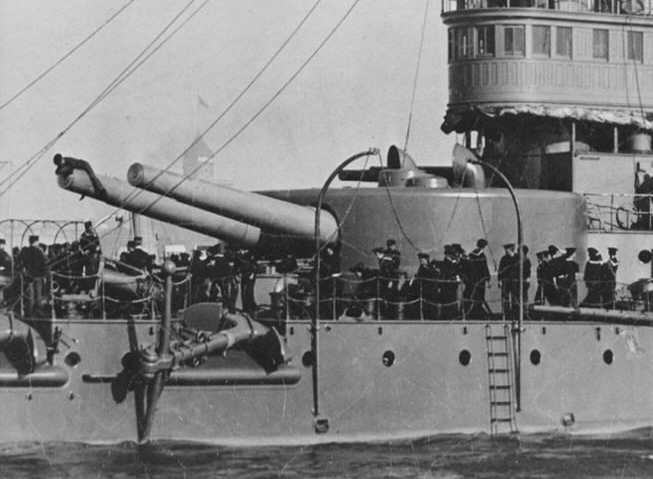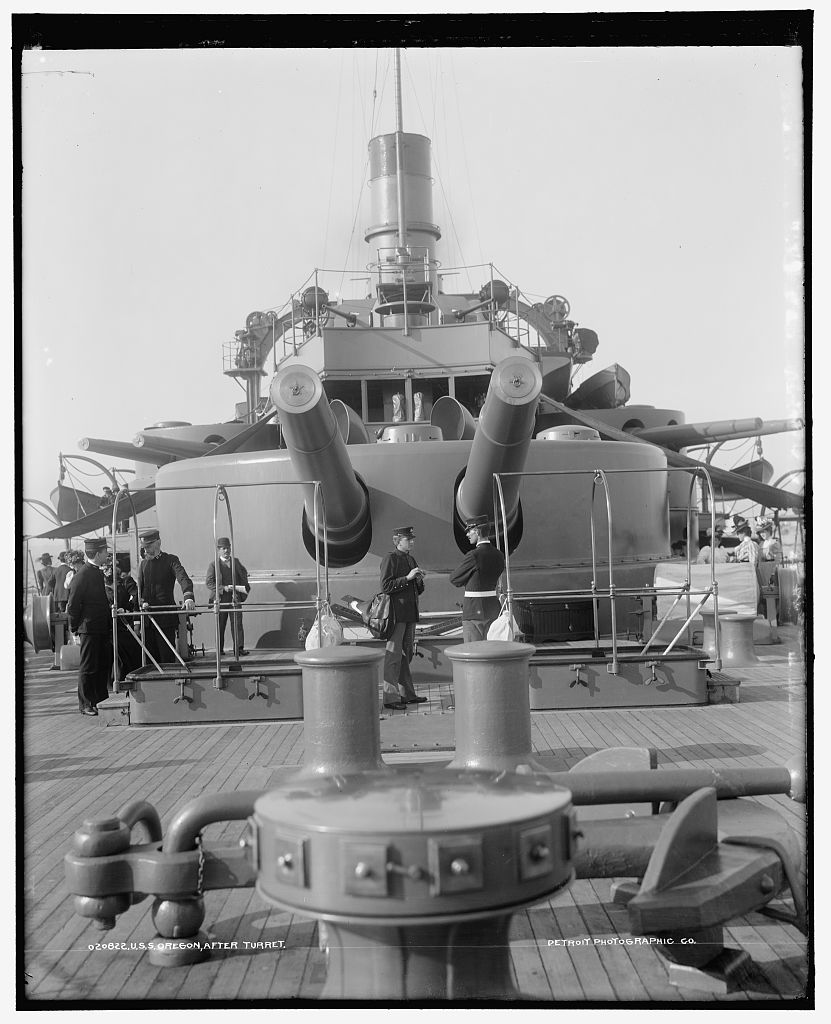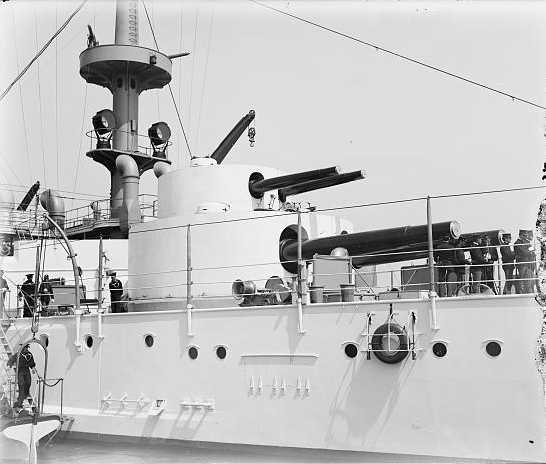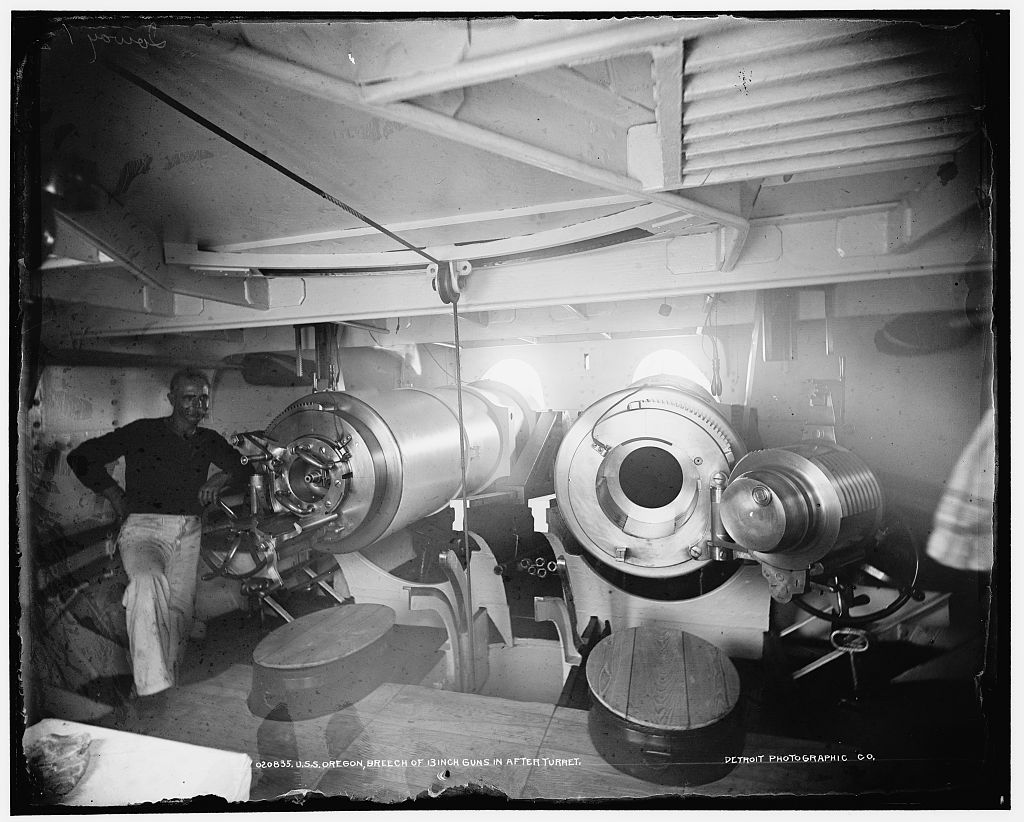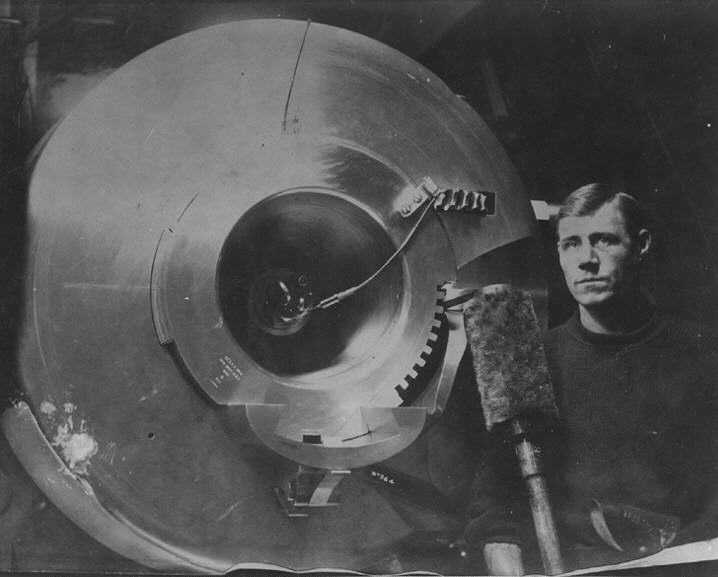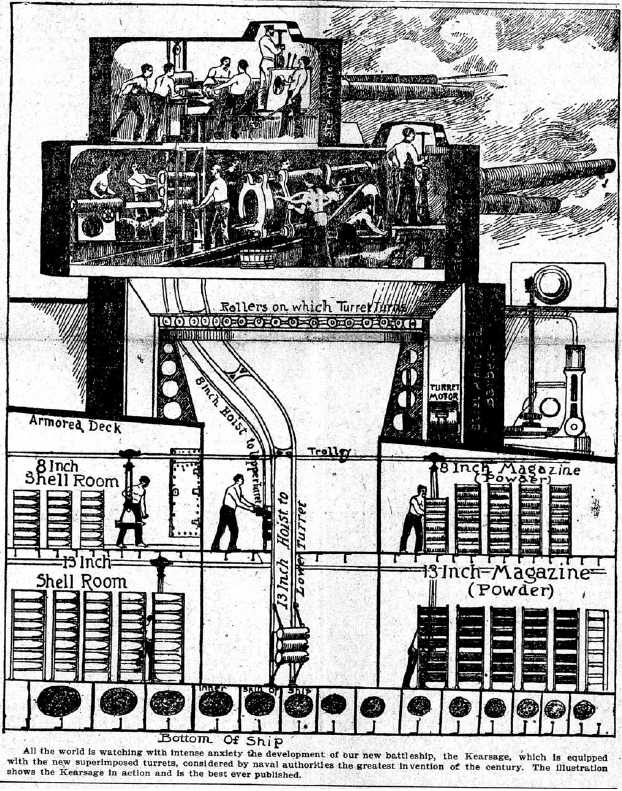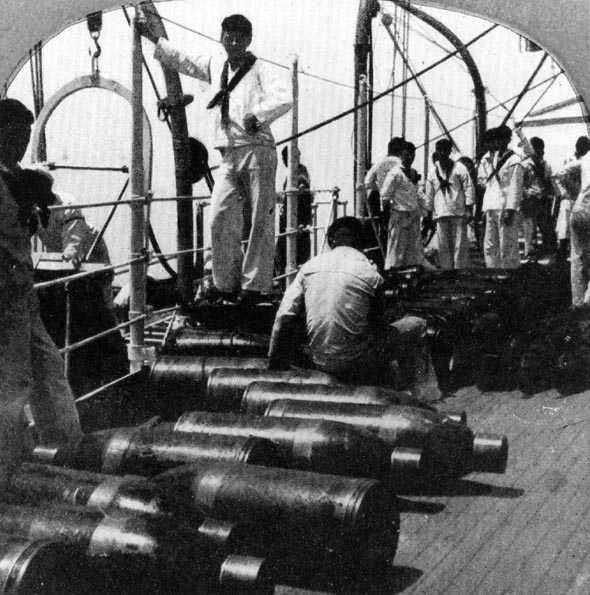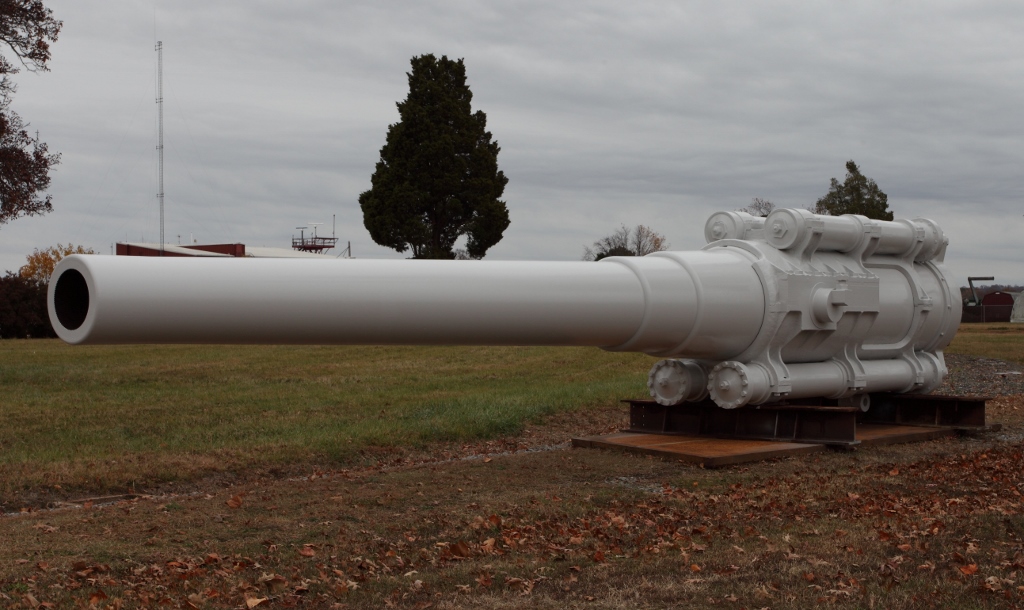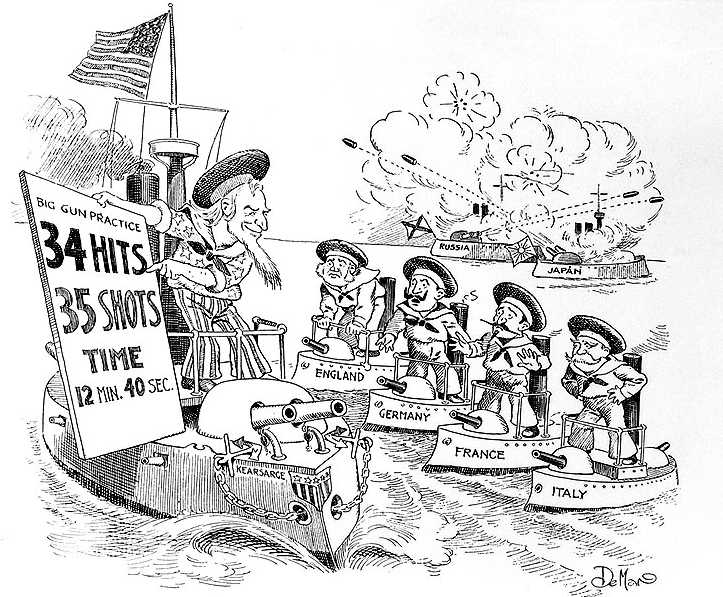USA 13"/35 (33 cm) Mark 1 and Mark 2 (original) (raw)
USS Indiana B-1. Note the 8" (20.3 cm) twin mount on the right and the awning support across the turret. U.S. Naval Historical Center Photograph # NH 52653.
In 1890 the Policy Board called for a variety of large caliber weapons, all the way up to 16" (40.3 cm). This large a caliber was beyond US manufacturing capabilities of the time, as the largest size possible was 13" (33 cm), so the Navy settled for this smaller caliber.
This gun was intended for short-range action against heavily armored targets and was fitted to the first true US battleship, the USS Indiana B-1. This was the only gun of this caliber ever developed for the US Navy.
Background note: The black powder propellants used for most of the 19th century burned very quickly, giving the projectiles a short, sharp kick. With these kinds of propellants, the longer the barrel, the slower the muzzle velocity. This was due to friction occurring after the propellant had completed combustion. This is why heavy guns for most of the 19th century had such short barrels, some only 20 calibers long. The late 1800s saw the development of brown or cocoa powder. This burned more slowly, which allowed a longer barrel length and thus increased the muzzle velocity. However, this propellant wasted much of its energy producing thick smoke.
Mark 1 Mod 0 consisted of 'A' tube, jacket and nine hoops. Mark 1 Mod 1 had a nickel steel liner and eight hoops. Mark 2 consisted of 'A' tube, jacket, seven hoops, and two locking rings. These guns used the Farcot side-swing breech mechanism and later converted to the Fletcher breech mechanism.
One Mark 2 gun was converted to a 16"/28.8 (40.6 cm) Experimental gun. See the photograph below. Another Mark 2 gun, Serial Number 33, was bored out to 14" (35.6 cm) sometime before 1923 and used for experimental purposes. A photograph of this gun may be found on the 9"/98 (22.9 cm) datapage.
| Designation | 13"/35 (33 cm) Mark 1 |
|---|---|
| Ship Class Used On | Indiana (B-1), Kearsarge (B-5) and Illinois (B-7) classes |
| Date Of Design | N/A |
| Date In Service | 1895 |
| Gun Weight | 137,900 lbs. (62,550 kg) (including breech)136,000 lbs. (61,690 kg) (without breech) |
| Gun Length oa | N/A |
| Bore Length | 455 in (11.557 m) |
| Rifling Length | N/A |
| Grooves | N/A |
| Lands | N/A |
| Twist | N/A |
| Chamber Volume | N/A |
| Rate Of Fire | As Commissioned with Black Powder: about 0.2 rounds per minuteca. 1915 with SP: about 1.0 rounds per minute |
| Type | Bag |
|---|---|
| Projectile Types and Weights | AP Mark 3 - 1,130 lbs. (512.6 kg)AP Mark 5 - 1,130 lbs. (512.6 kg)AP Mark 9 - 1,130 lbs. (512.6 kg)Common - 1,130 lbs. (512.6 kg) |
| Bursting Charge 1 | AP Mark 3 - 22.11 lbs. (10.0 kg) Explosive DAP Mark 5 - 36.12 lbs. (16.4 kg) Explosive DAP Mark 9 - 27.75 lbs. (12,6 kg) Explosive DCommon - 40.0 lbs. Black Powder (18.1 kg) |
| Projectile Length | AP Mark 3 - 43.58 in (110.7 cm) [3crh]AP Mark 5 - 42.22 in (107.2 cm) [3crh]AP Mark 9 - 46.05 in (117.0 cm) [7crh]Common - N/A |
| Propellant Charge | About 500 lbs. (227 kg) Black Powder180.0 lbs. (81.6 kg) SP 2 |
| Muzzle Velocity | 2,000 fps (610 mps) |
| Working Pressure | 14.0 tons/in2 (2,205 kg/cm2) |
| Approximate Barrel Life | N/A |
| Magazine capacity per gun | 60 rounds |
- ^
Earlier AP shells had Black Powder bursters of between 22.5 lbs. (10.2 kg) and 30.0 lbs. (14.0 kg). - ^
SP propellant was in three equal bags.
Ranges of AP shells with MV = 2,000 fps (610 mps)1a
| Elevation | Range | Angle of Fall | Time of Flight | Striking Velocity | Maximum Ordinate |
|---|---|---|---|---|---|
| 9.50 degrees | 10,000 yards (9,140 m) | 12.47 degrees | 18.89 seconds | 1,327 fps (404 mps) | 1,438 feet (438 m) |
| 10.82 degrees | 11,000 yards (10,060 m) | 14.13 degrees | 21.53 seconds | 1,281 fps (390 mps) | 1,438 feet (571 m) |
| 11.50 degrees | 11,500 yards (10,520 m) | 26 degrees | 22.53 seconds | 1,267 fps (386 mps) | 2,051 feet (625 m) |
| 15.00 degrees | about 12,000 yards (11,000 m) | N/A | N/A | N/A | N/A |
- ^
Values from "Range and Ballistic Tables 1935." - During the Battle of Santiago on 3 July 1898, the battleship Oregon (B-3) engaged in a running shoot with the Spanish cruiser Cristobal Colon. Oregon's last shots traveled 9,500 yards (8,700 m) and landed just ahead of the Spanish ship, convincing her to surrender. However, these rounds also "somewhat damaged" Oregon's guns due to the "high angle" (probably over +10 degrees) at which they were fired.
| Range | Side Armor | Deck Armor |
|---|---|---|
| 6,000 yards (5,490 m) | 12.13" (308 mm) | --- |
| 9,000 yards (8,230 m) | 10.09" (256 mm) | --- |
| 12,000 yards (10,920 m) | 9.11" (231 mm) | --- |
- This data is from "Ordnance Data Sheets" of 1905 as published in "US Naval Weapons."
| Range | Side Armor | Deck Armor |
|---|---|---|
| 6,000 yards (5,490 m) | 10.3" (262 mm) | --- |
| 9,000 yards (8,230 m) | 8.1" (206 mm) | --- |
| 12,000 yards (10,920 m) | 6.1" (155 mm) | --- |
- This data is from "Elements of US Naval Guns" of 1918 and is corrected for angle of fall. It may also refer to harder armor than used for the 1905 data. Data published in "US Naval Weapons."
| Designation | Twin Turrets Indiana (2): Mark 2 1d 2d Kearsarge (2): Mark 3 3d Illinois (2): Mark 4 4d |
|---|---|
| Weight | Mark 2: 440 tonsMark 3: 712 tons 5d Mark 4: 503 tons |
| Elevation | All: -5 / +15 degrees |
| Rate of Elevation | N/A |
| Train | about -150 / +150 degrees |
| Rate of Train | N/A |
| Gun Recoil | N/A |
| Loading Angle | Mark 2: +10 degreesMark 3 and 4: +2 degrees |
- ^
Defects in the design of the trunnions made it necessary to mount the guns so far back in the Mark 2 turrets that oversized gunports were necessary, negating much of the armor protection. - ^
The Mark 2 used on the Indiana class could create a list as large as 5 degrees when trained directly abeam. As the maximum elevation for these guns was +15 degrees, this list significantly reduced the maximum range. Hoists were single stage, running directly from the shell rooms to the gun breeches. - ^
The Mark 3 mounting used two 50 hp electric motors for training. Elevation, hoists and chain-driven rammers were also electrically powered. Run out in this mounting was a combination of spring and hydraulic cylinders. - ^
The Mark 4 was a balanced design and so eliminated the listing problem. The trunnions on the Mark 4 mountings were located close to the face plate, allowing for much smaller gunports and thus better protection. In other respects, it was similar to the Mark 3 with electric power and direct hoists. - ^
The Mark 3 had a superimposed twin8"/35 (20.3 cm) mount on top of the twin 13" (33 cm) mount, accounting for its much heavier weight compared to the Mark 2. - On 13 April 1906, exposed switch gear in the rear of one of the 13" (33 cm) mountings on Kearsarge (B-5) caused a powder burn, killing two officers and eight men, with four additional men being seriously injured. As a corrective measure, all electrical equipment that might cause a spark hazard were removed from all USN mountings between 1907 and 1908. Bulkheads were installed between the guns and breech gas ejectors were fitted to prevent flarebacks. A Note on Sources: "USN Naval Weapons" by Dr. Friedman on page 45 mistakenly says this accident was on USS Kentucky (B-6), Kearsarge's sister-ship.
The first 13" (33 cm) gun on the Indian Head Proving Grounds. United States National Archives Photograph courtesy of James P..
Forward turret on USS Oregon B-3. U.S. Naval Historical Center Photograph # NH 82644.
Another view of the forward Turret on USS Oregon B-3. U.S. Naval Historical Center Photograph # NH 42969.
After turret of USS Oregon B-3. This picture shows a typical armament of US pre-dreadnoughts of this time. 13" (33 cm) main armament, 8" (20.3 cm) secondaries and 3-pdr (1.85") anti-torpedo boat guns. Library of Congress Photograph ID LC-D4-20822.
USS Kearsarge B-5. Note the super-imposed 8" (20.3 cm) turret on top of the 13" (33 cm) turret. Detroit Publishing Company Collection Photograph and Library of Congress Photograph ID LC-D4-20480.
13" (33 cm) gun being replaced on USS Kearsarge (B-5) following an accidental ignition of powder charges for one of the 13-inch guns killed two officers and eight men. USN photograph courtesy of NavSource.
Inside one of the 13" (33 cm) turrets on USS Oregon B-3. These guns used Farcot breech mechanisms. Note the handles on the breech plug, used to manually pull the plug out of the breech and onto the carrier tray. Detroit Publishing Company Collection Photograph as Library of Congress Photograph ID ID LC-D4-20835.
Breech of one of the 13" (33 cm) guns on USS Oregon B-3 showing the later Fletcher breech mechanism. With two men operating the crank handle (hidden behind the gunner's head) the breech could be opened and closed again in 35 seconds. U.S. Naval Historical Center Photograph # NH 1895.
Newspaper sketch of Kearsarge Mounting. Text in this article says that the USN considered this mounting to be more effective than those on USS Iowa (B-4) by a factor of 42 to 24. Note that "Kearsarge" is misspelled in this article. Image from "America's Great Sea Terror newspaper article in "The Appeal" (Minneapolis-St. Paul) dated 02 June 1900.
13" (33 cm) projectiles being loaded aboard USS Kentucky B-6 about 1900. U.S. Naval Historical Center Photograph # 82666.
16"/28.8 (40.6 cm) Mark A Mod 0 Experimental Gun after being recently cleaned up and repainted. Note the "crank" at the far right which works the breech mechanism and which is still operable. This gun started life in 1898 as the 13"/35 (33 cm) Mark 2 Mod 1 Serial Number 23. It was converted in 1923 to the 16"/28.8 (40.6 cm) Mark A Mod 0 Experimental Gun. Gun was bored out and hooped to the muzzle in this configuration. This gun was fired seven times in July 1923 and then laid aside until 1956. Between October and December of that year, this gun was used for bomb tests and was then fired 19 more times. It is shown here on display at the Naval Surface Warfare Center in Dahlgren, Virginia. Maximum range in this 16" (40.6 cm) configuration with a 2,100 lbs. (953 kg) projectile and a muzzle velocity of 1,800 fps (549 mps) was 25,100 yards (22,950 m). Rifling was 96 grooves uniform RH 1 in 20. This photograph is copyrighted by NavWeaps.com as USN reference series NSWCDD-PN-15-00094.
"Pardonable Pride" by John L. DeMar, first published in 1905. Assuming that all guns were used, this cartoon implies that these guns could fire less than once per minute. U.S. Naval Historical Center Photograph # 95099.
"U.S. Battleships: An Illustrated Design History" and "US Naval Weapons" both by Norman Friedman
"The Big Gun: Battleship Main Armament 1860-1945" by Peter Hodges
"Battleships" by Paul Stillwell
---
"Six Killed on the Kearsarge" article published 15 January 1906 in the The Evening Star (Washington)
"Naval Ordnance" article in "Proceedings July 1894" Vol. 20/3/71 by P.R. Alger, Professor of Mathematics, U.S. Navy
---
"Naval Ordnance - A Text Book" revised in 1915 by Lt. Cmdr. Roland I. Curtain and Lt. Cmdr. Thomas L. Johnson
"Ordnance and Gunnery, A Text-book Prepared for the Use of the Midshipmen of the United States Naval Academy" by Officers of the U.S. Navy (1910)
"US Naval Guns - Marks and Modifications - Experimental Guns" dated 1956
"Range and Ballistic Tables 1935" by Department of Ordnance and Gunnery, U.S. Naval Academy
---
Tony DiGiulian's personal files
---
Special help from James P.
15 August 2008 - Benchmark
01 April 2010 - Replaced picture of Kearsarge, added picture of prototype 13" (33 cm) gun
07 October 2011 - Added newspaper sketch of Kearsarge mounting, moved two pictures to 8"/35 (20.3 cm) pictures page
11 February 2015 - Added note regarding 16"/28.8 Mark A gun
23 February 2015 - Added photograph and more information on gun converted to 16"/28.8 (40.6 cm) Mark A
31 January 2016 - Added note regarding Mark 2 Serial Number 33 being converted to a 14" (35.6 cm) test gun
12 March 2016 - Corrected typographical error
15 July 2016 - Converted to HTML 5 format
26 October 2020 - Added ammunition information
21 June 2023 - Added comments and photograph captions regarding Farcot and Fletcher breech mechanisms
09 August 2023 - Revised range table
10 January 2025 - Added photograph and expanded note regarding powder burn on USS Kearsarge (B-5)
